| Author: | |
| Website: | |
| Page title: | |
| URL: | |
| Published: | |
| Last revised: | |
| Accessed: |
| Year: | 1984 |
| Original platform: | IBM PCjr |
| Brief description: | Adventure game |
| Number of players: | One |
| Developers/contributors: | Sierra On-Line |
The story of King's Quest is not just the story of a computer game. It is the story of a software company (Sierra On-line) founded by Ken and Roberta Williams. The couple married in 1972, and originally lived in Los Angeles. Ken was nineteen years old, and his bride Roberta was even younger at the age of eighteen. Despite being a computer programmer, Ken found it necessary to take on freelance work in addition to his full-time job to support his wife and family (the couple's first son, D.J., was born in 1973). Roberta did her part to bolster the family finances, working as a computer operator. In 1979, Ken left his full time job to start his own software company, Online Systems. He was reportedly working on a taxation program for a customer's mainframe computer system when he came across a copy of William Crowther's 1976 single-player computer role-playing game Colossal Cave Adventure. He borrowed a computer terminal, and took the game home to show Roberta. His wife had a passion for fairy tales and stories of all kinds, and he thought (rightly as it turned out) that she would find the game interesting.
Both Ken and Roberta became fans of Crowther's game, although Roberta was perhaps the more enthusiastic of the two. She subsequently tried to find other computer adventure games to play, without success. Undaunted, she decided to write her own game. Her first foray into game creation was called Mystery House, and was based on the work of crime writer Agatha Christie. The game's main character finds themself locked inside an old and apparently abandoned Victorian mansion with a number of other characters, who (probably somewhat predictably) begin falling victim to an unknown murderer. The player's character must identify the murderer before they themselves become a victim. Although Roberta had come up with the story for the game, she felt that it would be more engaging for the player if the game had a graphical element rather than just being text-based. With that in mind she produced some preliminary sketches. She realised, however, that she would not be able to write the game's program code herself. She knew she had to somehow persuade Ken to get involved.
Ken meanwhile had discovered the joys of the Apple II personal computer whilst working on software projects with his brother, and had acquired one himself. The first games produced by Ken and Roberta Williams would therefore be targeted primarily at the Apple II personal computer. Ken would subsequently spend several months writing the program code for Mystery House, but the real challenge lay in translating Roberta's ideas for the game's graphics into images that could be generated by the computer. There were no commercially available graphic drawing programs around at the time. The solution, or at least part of the solution, came in the form of the Versawriter, an innovative piece of hardware manufactured by Versa Computing of Newbury Park, California.
The Versawriter essentially consisted of a flat plastic bed, approximately thirty-six centimetres long by thirty centimeters wide, on which the user could place drawings. The drawing was then covered with a transparent plastic overlay. Attached to the bed of the device was a jointed arm with an electronic position sensor at one end of it. The sensor could be moved freely over the drawing outline, enabling the user to produce a digitized version of their drawing. The software provided with the device allowed the user to perform a number of useful tasks, such as changing the background and foreground colours, filling in enclosed areas of the drawing with a solid colour, rescaling the drawing, creating shaded areas, and even adding text. In short, it included many of the basic features to be found in a modern computer graphics software package. The functionality provided was certainly sufficient to fulfill the Williams' requirements, and came at a price (a few hundred dollars) that they could afford.
The graphics for mystery house were not overly ambitious, consisting of static two-dimensional monochrome line drawings. Images were drawn with a white foreground colour on a black background, and were stored as vector graphics rather than bitmapped images. Additional information about each scene was provided using on-screen text. The player was still required to enter simple text commands in order to interact with the game, in the same manner as for purely text-based computer role-playing games. The real innovation in terms of programming was the code written by Ken Williams, which had to provide the game's underlying logic and render the game's graphics. The lessons learned in creating the software for Mystery House would later lead to the development by Sierra On-Line (as they would become known) of a series of increasingly sophisticated game engines.
Mystery House was completed in 1980, and the Williams placed an advertisement for the game in the personal computer oriented publication Micro Magazine. The game sold for just under twenty-five dollars, and was packaged in a Ziploc bag containing a five-and-a-quarter inch floppy disk and a printed instruction sheet. Copies of the game were available in software stores throughout the Los Angeles County area, and this first Online Systems game is estimated to have achieved sales of approximately ten thousand copies. Encouraged by their success, Ken and Roberta Williams announced that this was just the first of a series of games for the Apple II personal computer, for which they chose the name Hi-Res Adventures.
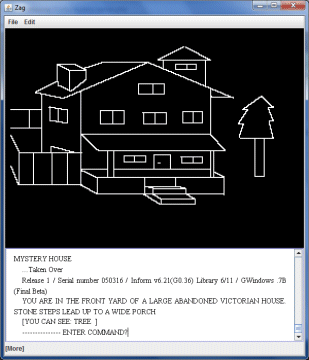
The opening screen of an online playable version of Mystery House
(http://www.turbulence.org/Works/mystery/games.php)
For the next game in the series, Roberta chose a very different theme. The game was called Wizard and the Princess, and the game's story, set in the imaginary kingdom of Serenia, reflected her lifelong love of fairy tales. The format of the game was otherwise identical to that of Mystery House, with players required to enter simple text commands. The major innovation was the use of colour, despite the fact that the Apple II could only display six colours. The user could be fooled into thinking that far more colours were present on the screen thanks to the use of a process known as dithering, in which adjacent pixels are displayed using two different colours to create the impression of a third colour. The new game was released later in the same year as Mystery House (1980), and like its predecessor was packaged in a Ziploc bag containing a five-and-a-quarter inch floppy disk and a printed instruction sheet. Wizard and the Princess was even more successful than Mystery House, and reportedly sold around sixty thousand copies.
The financial success of their first two games was such that Ken and Roberta Williams, who had meanwhile been blessed with a second son, Christopher, were able to fulfill their ambition of moving out of Los Angeles and into the home of their dreams in Oakhurst, California, not far from Yosemite National Park. They also opened their first official offices in Oakhurst, but changed the name of the company to Sierra On-Line following the discovery that the name Online Systems was already being used by another company. By the end of 1983, six games had been produced in the Hi-Res Adventure series, culminating in The Dark Crystal, based on Jim Henson's animated fantasy film of the same name, and produced in collaboration with Jim Henson. In terms of gameplay, the games all followed more or less the same format. The Hi-Res Adventure series was so successful that Sierra had to recruit additional staff to cover the increased workload. Perhaps just as significantly, Sierra was beginning to attract the attention of major players in the computer industry.
Obviously aware of the emergence of a diverse range of personal computing platforms, Ken Williams had foreseen the need to adapt the games, which were initially written for the Apple II, so that they could be ported to other popular personal computers. Target platforms included the IBM Personal Computer, the Atari ST, and the Commodore 64. IBM were meanwhile developing their PCjr personal computer, which was intended primarily for home and educational use. They approached Sierra On-Line to develop a game to help to show off the hardware capabilities of their new computer, which boasted one hundred and twenty-eight kilobytes (128 kB) of memory, a graphics chip that offered six display modes and could display up to sixteen different colours simultaneously, and a programmable sound generator chip developed by Texas Instruments that included three separate tone generators. The game put forward by Sierra On-Line for the PCjr was Roberta Williams' most ambitious project to date - King's Quest.
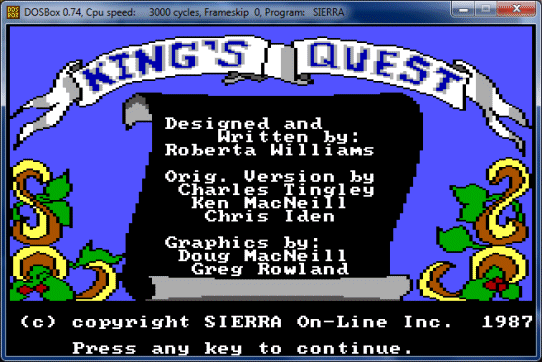
The opening screen of the 1987 DOS version of King's Quest
The screenshot above shows the opening screen of the 1987 version of King's Quest, which has a screen resolution of 640 x 400 pixels. Incredible as it may sound given the high screen resolutions available today, the version initially created for the IBM PCjr used the computer's 320 x 200 pixel EGA (Enhanced Graphics Adapter) mode. Realising that the program code used for the HI-Res Adventure series of games would not be up to the task, Sierra's programmers created a new game engine for King's Quest, which they named the Adventure Game Interpreter (AGI). The AGI game engine controlled the game's logic, rendered the game's graphics, and played the game's sound. Although initially designed around the hardware capabilities of the PCjr, it was also designed to be platform independent. This turned out to be a sound strategy on the part of Sierra On-Line. IBM's PCjr personal computer turned out to be a commercial failure, mainly due to its high price tag (by comparison with other personal computers of the day) and poorly designed keyboard.
An interesting technical issue arises here, since I have stated above that the game ran on the IBM PCjr at a resolution of 320 x 200 pixels. This would certainly have been the most appropriate resolution given the IBM PCjr's hardware specification, but all the documentation I have come across so far suggests that Sierra's AGI game engine was based on a resolution of 160 x 200 pixels. There is no doubt in my mind however, having viewed video footage of the game actually running on an IBM PCjr, that the resolution being displayed must be 320 x 200 pixels. The anomaly can be explained if you assume (since the game engine produces vector graphics rather than bitmapped images) that all of the screen coordinates have their x-values increased by a factor of two before the images are displayed. If anyone knows differently, maybe they could email me. At any rate, since vector graphics can cause considerable screen flicker when drawn directly to the screen (especially on slower hardware) the image vector information is used to create a bitmapped image which is temporarily stored in a memory buffer. The resulting bitmap is then copied into the screen display memory, and the completed image is displayed on the screen without flicker. This process is known as a bit-block transfer (sometimes called a "bit blit").
This first game in the King's Quest series has a similar theme to Wizard and the Princess, although it is far more ambitious in its scope. It takes its inspiration from the fairytales and other stories that Roberta so enjoyed. The game's story is set in the kingdom of Daventry, which is ruled over by King Edward the Benevolent. The kingdom's fortunes are somewhat dependent upon three artifacts that are invested with special powers - a magic mirror that can be used to foretell the future, a shield that protects the wearer from harm, and a treasure chest that contains an inexhaustible supply of gold. These artifacts have been used in various ways to maintain the security and continued prosperity of the kingdom. At the time the story begins, however, the three items are no longer in the possession of the royal family of Daventry. An evil sorcerer has obtained the magic mirror, a mysterious dwarf has gained possession of the shield, and a wicked witch has stolen the treasure chest.
To compound matters, Edward's queen has died, leaving him without an heir. Bereft of its treasures, the kingdom has suffered a steep decline in its fortunes, and is vulnerable to attack from hostile neighbouring lands. In desperation, King Edward summons the bravest knight in his realm, Sir Graham, and promises him the throne if he can retrieve the kingdom's three treasures. It's not going to be easy though. As you can see from the screenshot below, there is a real possibility of Sir Graham meeting an untimely death before he has even arrived at the castle to answer the King's summons! Of course, the presence of alligators in what otherwise looks like a typical medieval castle moat, possibly somewhere in Ye Olde England (or at least Europe) stretches the imagination somewhat, but it sets the scene for the kind of thing you can expect throughout the game, and indeed throughout the entire series of King's Quest games.

Sir Graham faces dire peril even before he meets with the King
The screenshot above serves to illustrate the graphic nature of the game. The game world and its characters are depicted in a third-person perspective, and although the graphics are still very much two-dimensional, a partial three-dimensional quality is added due to the fact that the character can move over, under, behind, or in front of objects or other characters. Note that text commands (entered at the prompt at the bottom of the screen) are still used to undertake specific actions, but Sir Graham's movements around the game world are controlled by the player using the keyboard's left, right, up, and down arrow keys. The other really exciting thing at the time the game was released was the fact that that both the characters and many of the objects in the game world were animated. Although the game Dragon's Lair had featured high-quality animation, player interaction was essentially limited to choosing between different cut scenes at pre-defined points in the game. In King's quest, the player has total control of the main character's movements and actions using a combination of keystrokes and text commands.

The player can direct Sir Graham to take specific actions using text commands
You will notice that, as you approach the boundary of a particular scene, you will automatically move into the nearest adjacent scene. The game is in fact designed as an eight-by-six grid (imagine something like a Chess board with six rows of eight squares), with forty-eight separate scenes. There are also a further thirty-two scenes, accessible from the main grid, used to depict the inside of caves, buildings, and other types of environment. The game world is designed to wrap around on itself so that if (for example) you move Sir Graham far enough to the north, he will end up at the southernmost boundary of the game world. As you progress through the game, you will be awarded points for various actions taken, tasks completed or puzzles solved. The points are displayed at the top of the screen, on the left-hand side. In all, one hundred and fifty-eight points are available, although you do not need to get all of the points to complete the game. You will also be able to collect various artifacts as you progress through the game, at least some of which will be required at some later stage in order to retrieve the various treasures and return to the court of King Edward in one piece.
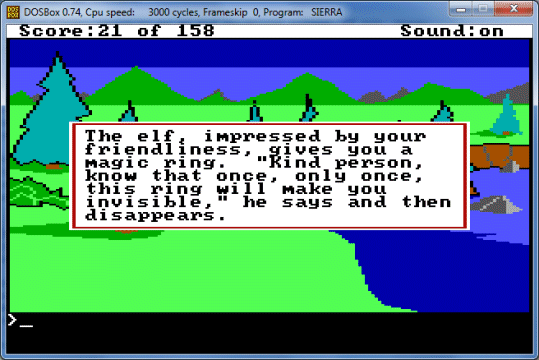
Various useful artifacts can be acquired during the course of the game
In the later stages of the game, you will be required to solve a number of puzzles. As well as the various artifacts that you can collect throughout the game (some of which are more useful than others), you will also come across snippets of information or hints that will help you solve the puzzles that you are presented with later in the game. The information presented to you may not immediately make sense, but it is worth remembering, since there is a good chance that a context will arise in which it does make sense. If your memory is anything like mine, you would be well advised to write any such information down on a piece of paper.
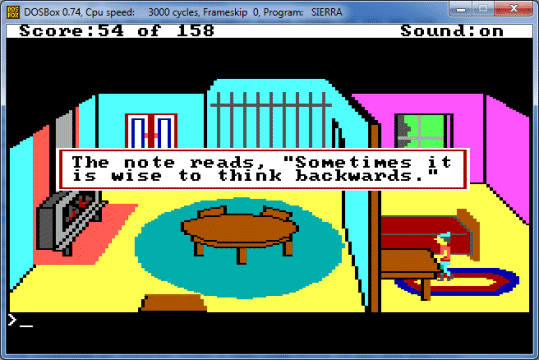
Any information you receive should be recorded for possible use later in the game
The puzzles that must be solved in the game often involve doing the right thing in a given situation, but they often also depend on having a suitable artifact to hand when the time comes. Roberta Williams usually designed her puzzles so that there were two possible solutions, one of which would require more thought (or at least a more subtle approach) than the other. The more sophisticated solution invariably earns the player additional points. In order to retrieve the magic mirror, for example, Sir Graham must confront a dragon in its underground lair. Sir Graham has in his possession (at least if he has been diligent in acquiring the various artifacts available throughout the game) a dagger. Having entered the dragon's cave through a well, he may also have in his possession a bucket filled with water. Throwing the dagger at the dragon will (believe it or not) kill the dragon, leaving Sir Graham free to retrieve the magic mirror. On the other hand, throwing the water over the dragon will extinguish the dragon's fiery breath, rendering it relatively harmless and preventing the need to actually kill it.

The more sophisticated solution to a particular puzzle brings extra points
In reality, unless you do what I did and cheat (!!), you will probably meet an untimely death on more than a few occasions before overcoming all the obstacles and solving all the puzzles in the game, let alone figuring out the optimum solution to each puzzle. Because time is always an issue for me, I used one of several available online walk-throughs (step-by-step instructions on how to tackle the various tasks) in order to complete the game. The secret with this game, as with many others, is to save your game after each milestone achieved, so that in the highly likely event of your death (upon which Sierra offer their most sincere condolences), you can resume the game without having to go right back to the start. All in all, the game is quite a challenge, and can take a considerable amount of time to complete if you don't resort to seeking outside help. But then, that's the whole point of a game, isn't it?
One of the most difficult puzzles to solve comes near the end of the game, where you are confronted by a "crotchety old gnome". When you approach the gnome and speak to him, he tells you that he can give you something of value providing you can correctly guess his name. Those of you who are as familiar with German fairy tales as Roberta Williams obviously was may surmise that the name of the gnome is "Rumplestiltskin". This, however, is not quite the answer that is required here. Whilst pondering the solution to the puzzle, you may remember a hint that you memorised earlier in the game (or, as in my case, refer to something you wrote down on a piece of paper at the time). The advice takes the form of a note (as depicted in one of the screenshots above) that says "Sometimes it is wise to think backwards". So you nod wisely to yourself and type in the name "Nikstlitselprum".
Unfortunately, this doesn't seem to work either. Oh dear, it could take a very long time to finish the game! The answer, in fact, is to take the letters of the name you (probably) first thought of - Rumplestiltskin - and work out the position within the alphabet of each letter. You then need to reverse the order of the letters of the alphabet, and take the letter corresponding to the original position for each letter of the new name. Roberta Williams was obviously a very devious lady. Anyway, the result you should come up with is "Ifnkovhgroghprm". Once you have correctly worked out the name of the crotchety old gnome, he will give you some magic beans which will no doubt come in handy for something (magic beans on toast, for example). Actually, as you may have already guessed, the beans will be used to grow a giant beanstalk. Hmm . . . where have I heard that before?

The hardest puzzle in the game is to guess the old gnome's name
Climbing the beanstalk proves to be a lot harder than it at first appears, so you would be well advised to save your game before you start this endeavor. Actually, you will probably need to save your game at various stages on the way up the beanstalk as well. A single false move at any one of several points on the climb will see Sir Graham plunge to an untimely demise. Once you manage to climb the beanstalk, you find yourself at the top of a mountain where a giant lives (no surprise there, then). It's not the only way to get up there, and certainly not the easiest, but it is the most advantageous from the point of view of earning points. The giant has in his possession the missing treasure chest, which you must of course obtain. As with the fire breathing dragon, there are two alternative courses of action. If you have found the sling (hidden somewhere on the mountain in a hole in a tree), you can simply kill the giant with it and steal the chest. Alternatively (and worth more points) you can simply avoid him until he falls asleep, and then steal the chest. If you acquired the magic ring from the elf earlier in the game, you can use it here to make yourself invisible.
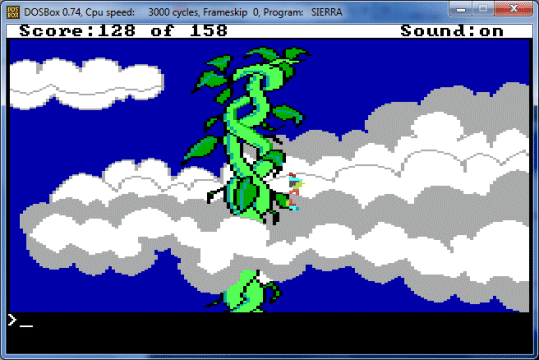
Climbing the beanstalk takes you to the top of a mountain
Once you have found all three of the treasures that belong to the Kingdom of Daventry, you can return to the castle of King Edward and claim the throne. The order in which you retrieve the treasures is not particularly important, but it makes life much easier if you have the appropriate artifacts in your possession before you encounter a situation in which they can be used to advantage. If not, you may find yourself backtracking in order to obtain the required item. Of course, this is easier said than done, and hindsight is indeed a wonderful thing. Note that even after you have obtained all three treasures, you can still lose them (look out for thieving dwarves, sorcerers and the like) and you can still die if (for example) you wander into the raging river, or even the castle moat (the alligators are still there). Sadly, your triumphant return will also lead to King Edward having a heart attack, but that's life, I suppose.
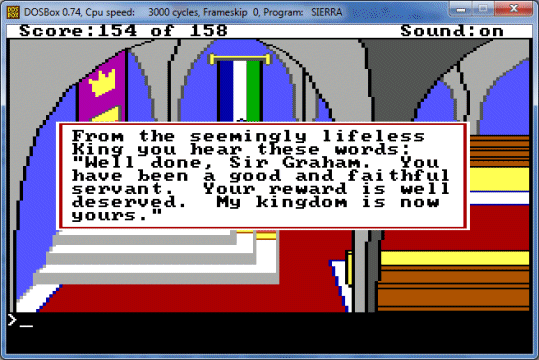
Upon Sir Graham's return, the King suffers a heart attack and dies
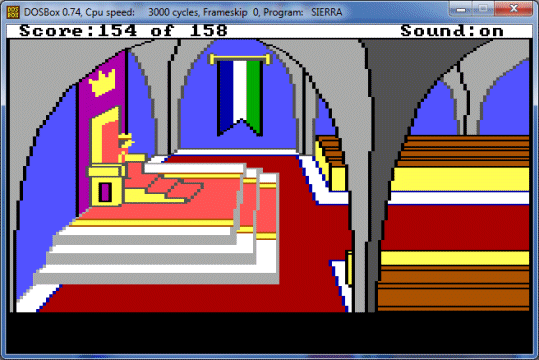
Sir Graham becomes King of Daventry at last
King's Quest was released in 1984, timed to coincide with the release of the IBM PCjr. Although the PCjr suffered from much poorer than expected sales and was cancelled the following year, Sierra had been prudent in retaining all rights to the game. They subsequently produced ports for many other popular personal computing platforms. Notable among these was the version produced for the Tandy 1000, which was also released in 1984. The new Tandy computer, unlike IBM's ill-fated PCjr, was a commercial success. It was also compatible with the IBM PC, and boasted a similar hardware capability in terms of graphics, audio, processing power and memory, to the PCjr. King's Quest thus reached a large and appreciative audience, despite the failure to launch of the PCjr.
King's Quest spawned seven sequels in total. The first of these is King's Quest II: Romancing the Throne, which was released in 1985. Graham is now King of Daventry and the land is prospering. Despite being loved by his subjects, however, Graham is lonely. He has no queen, and hence no prospect of an heir to the throne. Then one day, looking into the magic mirror, he sees a vision of a quartz tower that can only be accessed via a magic door located in the nearby land of Kolmya. It is subsequently revealed to Graham that a beautiful girl is imprisoned in the tower. Realising that this must be his future bride, Graham sets off to rescue her from the quartz tower. During this adventure, Graham will encounter several literary and mythological characters, including Little Red Riding Hood, Count Dracula, and King Neptune.

In King's Quest II, King Graham encounters various well-known fictional characters
Needless to say, Graham will ultimately be successful in his quest to rescue the fair maiden (her name is Valanice), who of course will then become his queen. Although this second installment in the King's Quest series features a totally different landscape and completely new scenes, the gameplay is more or less identical to that of the first game. One significant difference is that the landscape no longer loops around on itself when the player moves continuously in an easterly or westerly direction. Instead, natural barriers present themselves in the form of the sea to the west, and mountains to the east. Looping still takes place from north to south, however, and vice versa. The version originally released for the IBM PC came on two five-and-a-quarter inch floppy disks or one three-and-a-half inch floppy disk.
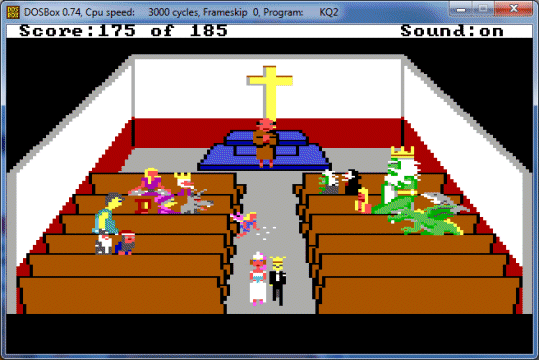
Graham eventually rescues Valanice, and she becomes his queen
In 1986, Sierra released the third installment in the King's Quest series, King's Quest III: To Heir is Human. Like its predecessor, King's Quest III is not set in Daventry. Fans of the series were unperturbed by the change of scenery, but were initially somewhat put out by the fact that King Graham is no longer the main character. In the opening screens of the game we are introduced to the game's protagonist, a seventeen year old boy called Gwydion. For as long as he can remember, Gwydion has lived with a cruel and evil wizard called Manannan. Treated like a slave and forbidden to leave the Wizard's house, Gwydion has no idea of how he came to be in the situation in which he finds himself. The game's manual tells us that Manannan kidnaps a one year old boy every seventeen years to be his slave. The fate of each boy is already sealed, since Manannan will not allow them to grow to manhood. Fearing that an adult slave will become too bold or inquisitive to be easily controlled, Manannan kills each boy on his eighteenth birthday.
Gwydion must take advantage of the wizard's frequent but all too brief absences in order to find or steal the ingredients for various magic spells that he can eventually use to render the wizard harmless and escape. The spells themselves can only be found in the game's manual - a subtle form of copy protection. If caught in the act of stealing, or discovered to be somewhere he shouldn't be, Gwydion will be killed by the wizard. He must hide any items he obtains under his bed (where, apparently, they can't be seen by the wizard) until such time as they can be used to his advantage. The player is very much working against the clock in this game, and only has a short time in which to find and acquire the items they will need in order to cast the various spells. Some of these items can be found in Manannan's secret workshop in the cellar, while others reside in a number of different locations in the countryside surrounding Manannan's mountaintop retreat.

Gwydion must enter Manannan's workshop to cast magic spells
From time to time during the game, Manannan will either make a short journey or take a nap. Each time Manannan is absent, Gwydion has twenty-five minutes (in real time) to find ingredients for spells and perform the necessary rituals. The rituals can only be performed in Manannan's workshop, and must be carried out exactly in accordance with the instructions in the spell book (i.e. the game's manual). If a mistake is made, the results will be catastrophic for Gwydion. As with previous games in the series, any misstep during the game is likely to be fatal, so the player is well advised to save their game after making significant progress. They can then restore the game in the event of Gwydion meeting an untimely end. Before Manannan returns from a trip or awakens from a nap, Gwydion must hide both his possessions and any evidence of having been in Manannan's workshop. In the event of Manannan returning from a trip, he will demand food. Gwydion must therefore ensure that he has something for Manannan to eat. For obvious reasons, food items that are required for spells should not be used.
If Gwydion forgets to cover his tracks, or is discovered in possession of items that can be used for magic spells (which would reveal that he has been to places he is not permitted to go), Manannan will literally "zap" him out of existence and the game is over. The inventory command can be used to check whether Gwydion is currently carrying any possessions, and if so whether any of those possessions will get him into trouble (all such items in the inventory list are marked with an asterisk). From time to time, Gwydion will come across bandits and other characters on his travels that will steal his possessions if they get the chance. The best way to deal with this problem is to avoid these characters altogether. Failing that, in the event of Gwydion losing his possessions due to theft, a previously saved game can be restored. Since the appearance of characters with a predisposition to theft is usually purely random, Gwydion is unlikely to encounter this problem every time they enter a particular scene.
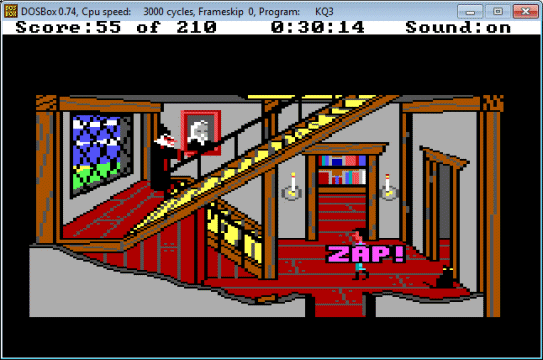
Gwydion will be zapped if Mannaman discovers he is gathering ingredients for spells
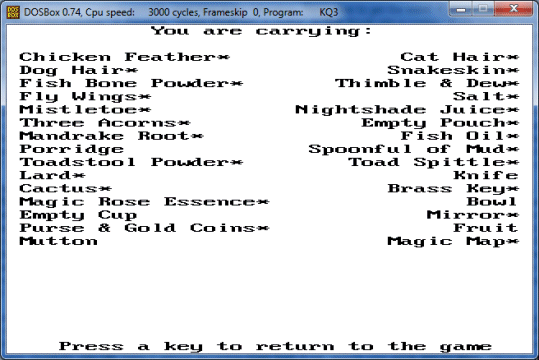
The inventory command reveals what Gwydion is carrying
At some point in the game Gwydion will be told by an oracle that he is actually Alexander, a prince of the royal house of Daventry, kidnapped by Manannan as an infant. He is also informed that Daventry is being terrorised by a monstrous three-headed dragon that periodically demands the sacrifice of a fair maiden. He is also told that (purely by coincidence, of course!) the dragon's next victim will be Alexander's twin sister, Rosella. Once Gwydion has managed to dispose of Manannan (either by turning him into a cat or poisoning him) he must attempt to return to Daventry to save his sister from becoming the dragon's next meal. This will involve a sea voyage, courtesy of some not particularly friendly pirates, and an encounter with the Abominable Snowman.
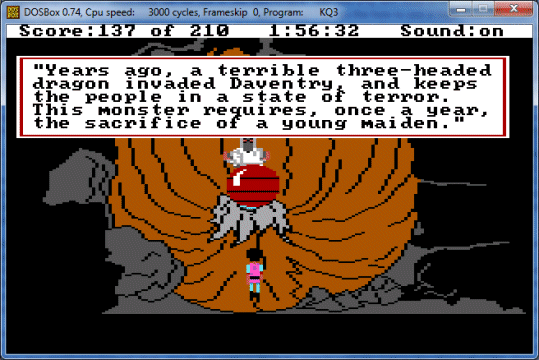
An oracle reveals to Gwydion (Prince Alexander) everything that has occurred
Once Alexander has arrived in Daventry he is greeted by an old gnome, who has apparently been expecting him. The gnome tells him that time is running out for Rosella, and that he must make haste to confront the dragon and rescue his sister. The dragon can be defeated, but only by using two of the magic spells acquired from Manannan's spell book. Alexander must first make himself invisible so that the dragon will not incinerate him on sight, and then conjure up a storm that will strike the dragon with lightning bolts and kill it. Our hero has, in fact, had to use magic frequently throughout the game in order to escape Manannan and other hostile entities. Indeed, one of the items that Gwydion/Alexander must use in his quest is a magic map that he steals from Manannan. At certain points in the game, the map enables him to instantly teleport to almost any location he has already visited.

Prince Alexander must save Rosella from a three-headed dragon
The map feature was reportedly frowned upon by some King's Quest fans because they thought it made the game too easy to play. In any event, it did not appear in later games in the King's Quest series. The game was released on three five-and-a-quarter inch floppy disks or two three-and-a-half inch floppy disks. Tweaks to the Adventure Game Interpreter (AGI) had provided improvements in the quality of both graphics and sound, which prompted a remake of the original King's Quest game in 1987. The remake included support for a sound card, VGA graphics, and a mouse. Nevertheless, the AGI was showing its age. The next game in the series, King's Quest IV: The Perils of Rosella, would be the last appearance for the AGI. The new game would also (as the title clearly suggests) feature Princess Rosella as the game's main character. At this point in our story, the King's Quest series of games had already earned its place in gaming history. The fan base was growing rapidly, and Sierra On-Line's fortunes were going from strength to strength. We will pick up the story again in a separate article, starting with the release of King's Quest IV in 1988.